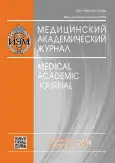THE ROLE OF SYMPATHIC AND PARASIMPATIC INNERVATION IN NEUROIMMULAR INTERACTIONS WITH EXTERNAL GUINETAL ENDOMETRIOSIS
- Authors: Andreev AE1,2, Drobintseva AO1,2, Polyakova VO1,3
-
Affiliations:
- Research Institute of Obstetrics, Gynecology and Reproductology named after D.O. Ott, Saint Petersburg
- Saint Petersburg State Pediatric Medical University, Saint Petersburg
- Saint Petersburg State University, Saint Petersburg
- Issue: Vol 19, No 1S (2019)
- Pages: 56-58
- Section: Articles
- Published: 15.12.2019
- URL: https://journals.eco-vector.com/MAJ/article/view/19323
- ID: 19323
Cite item
Abstract
Currently the study of the role of peripheral nervous system in control of inflammation in endometriosis and its involvement in the development of the chronic pain syndrome in this pathology is of relevance. The purpose of this work was to assess the reciprocal location of sympathetic and parasympathetic nerve fibers with external genital endometriosis at various stages of progression. The samples for the study were the endometrial biopsies of patients of reproductive age with external genital endometriosis of I-IV stage of the disease, with primary sterility (n = 20). The control group consisted of 3 patients (n = 5) who did not have any signs of endometriosis. Molecular markers were visualized using the immunohistochemical method. Antibodies to tyrosine hydroxylase (TH, 1:200, Abcam, USA) and PGP 9.5 (PGP 9.5, 1:1000, Abcam, USA) were used as primary antibodies. Alexa Fluor 488 (1:1000, Abcam, USA) and Alexa Fluor 647 (1:1000, Abcam) were used as secondary antibodies. The results were visualized with a confocal microscope (FluoView1000 (Olympus)). 3D shooting was used to assess the reciprocal location of the studied markers. As a result of this work, it was found that the expression of both of studied markers was detected in all samples. The obtained data can significantly increase the understanding of the functioning mechanisms of the neoneurogenesis processes in ectopic and eutopic tissue, thereby allowing an increase in the accuracy of the endometriosis diagnostic methods.
Keywords
Full Text
About the authors
A E Andreev
Research Institute of Obstetrics, Gynecology and Reproductology named after D.O. Ott, Saint Petersburg; Saint Petersburg State Pediatric Medical University, Saint Petersburg
A O Drobintseva
Research Institute of Obstetrics, Gynecology and Reproductology named after D.O. Ott, Saint Petersburg; Saint Petersburg State Pediatric Medical University, Saint Petersburg
V O Polyakova
Research Institute of Obstetrics, Gynecology and Reproductology named after D.O. Ott, Saint Petersburg; Saint Petersburg State University, Saint Petersburg
References
- Министерство здравоохранения Российской Федерации, Департамент мониторинга, анализа и стратегического развития здравоохранения, ФГБУ «Центральный научно-исследовательский институт организации и информатизации здравоохранения» Минздрава: Заболеваемость взрослого населения России в 2016 году // Статистические материалы. Часть II. - М., 2016.
- Ярмолинская М.И., Айламазян Э.К. Генитальный эндометриоз. Различные грани проблемы. - СПб.: Эко-Вектор, 2017. - 615 с.
- Адамян Л.В. и др. Эндометриоз: диагностика, лечение и реабилитация. Федеральные клинические рекомендации для ведения больных. - М., 2013. - 65 с.
- Tokushige N, Markham R, Russell P, Fraser IS. Nerve fibres in peritoneal endometriosis. Hum Reprod. 2006;21(11):3001-3007.
- Miller EJ, Fraser IS. The importance of pelvic nerve fibers in endometriosis. Womens Health (Lond). 2015;11(5):611-618.
- Патент РФ №RU2657787C1. 15.06.2018. Иммуногистохимический способ выявления симпатических и парасимпатических структур на гистологических препаратах // Патент России RU2657787C1. 2018 / Inventor Е.И. Чумасов, Д.Э. Коржевский, Е.С. Петрова.
Supplementary files







